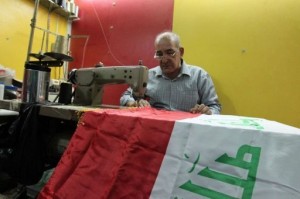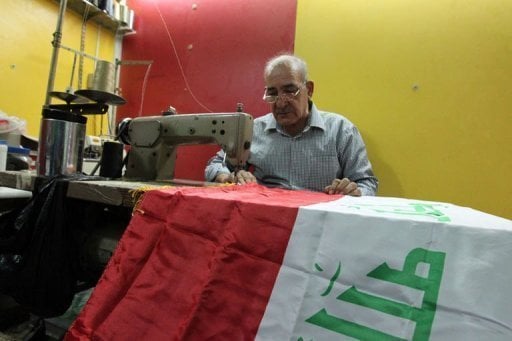
An Iraqi tailor sews a national flag at his workshop in Baghdad
AFP Photo / Sabah Arar
BAGHDAD (AFP) — Iraq is seeking to replace its national anthem and flag in a move aimed at providing unifying national symbols and putting decades of conflict and hardship in the country behind it.
“We are determined to finish the new flag and anthem this year, in this legislative session,” MP Ali Shlah, the chairman of parliament’s culture and media commission, told AFP.
Shlah said a new anthem and flag “will be a unifying factor” for Iraqis, who have suffered decades of violence, privation and division.
Now-executed dictator Saddam Hussein started a war with Iran in 1980 that lasted for eight years, and then launched a disastrous invasion of Kuwait in 1990 only to be forced out in the 1991 Gulf War and hit by a harsh regime of international sanctions.
The country has also lived under an ever-present threat of bombings, assassinations, gun battles and death squad killings since a US-led coalition toppled Saddam in 2003, in which tens of thousands of people have died.
Iraq’s current national anthem, “Mawtini” (“My Homeland”), was adopted in 2004 on the order of Coalition Provisional Authority chief Paul Bremer, who admired the song when he heard it at a concert.
The 2004 change was the fifth time that a new Iraqi national anthem had been adopted.
More than 400 texts by Iraqi poets were submitted as potential national anthems between 2008 and 2009, Shlah said, but the search for an anthem is ongoing.
Earlier this year, the culture and media committee tasked six Iraqi writers with evaluating potential national anthems.
They have narrowed it down to three candidates — “Salam ala Hadhabat al-Iraq” (“Peace on the Hills of Iraq”); “Ghareeb ala al-Khaleej” (“A Stranger on the Gulf”); and “Watani al-Haq Yuaiduhu” (“My Country is Supported by Right”).
In discussions on the poems, Iraqi Kurds, Turkmen and Assyrians called for verses in their languages to be added, but a compromise was reached whereby the words “Long live Iraq” would be said at the end in various languages.
Shlah said parliament is preparing a second reading of a law on the anthem, after a first reading two months ago, adding that “Peace on the Hills of Iraq” is the current leading candidate.
Agreeing on a new flag and anthem carries a good deal of symbolism, both in moving on from the past and requiring Iraqi politicians to reach a consensus — something that has proved elusive on a wide variety of issues.
“This country, which has witnessed conflicts for decades, will not achieve peace as long as it cannot agree on an anthem and flag,” said Ahmed, a 33-year-old electrical engineer who works for a foreign company in Baghdad.
The selection of a new anthem appears to be on track, but choosing a new flag is more problematic, although a previous committee narrowed dozens of designs down to six.
There was another proposal for a flag dating from the rule of Abdul Karim Qassem, who overthrew Iraq’s monarchy in a bloody coup in 1958, to be adopted, but “this choice faced objections about the person of Abdul Karim Qassem, who symbolises a certain era,” Shlah said.
And he said that some people want to keep the current flag, as modifications to it mean that “it is no longer Saddam’s flag.”
Today’s flag will be submitted along with six other designs from artists to a committee for review, he said.
The current flag, a design that was adopted in 2008, consists of three horizontal bars — red, white and black. The middle bar bears the words “Allahu Akbar” (“God is Greatest”), written in green in the Kufi style of Arabic script.
Iraq’s flag has been changed a number of times over the years — the 2008 design dropped three stars in the middle bar, while in 2004, the script used for the text was changed to Kufi style from one said to be based on Saddam’s handwriting.
The text was added in 1991, while the meaning attributed to the stars changed over the years — they were said to represent unity between Iraq, Egypt and Syria when Arab nationalism was in the ascendancy, but later said to symbolise the Baath party goals of unity, freedom and socialism.
Iraq’s first flag was adopted under the monarchy in 1925.
According to parliament’s website, the new Iraqi flag should express “the unity of Iraq’s land and people,” and “look optimistically to its future and proudly to its history.”


